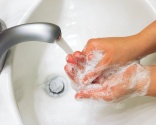Home › magazine › latest news › Hand washing why so vital?
Hand washing - why so vital?
23rd of December 2015Much work has been done in the promotion of good hand hygiene practice, and that work continues to be necessary. But why exactly is hand hygiene so vital? What are the bacteria to be found on the hands, are they all potentially dangerous, how long do they remain active and how are they passed on? And how do we select the right products to combat those hand hygiene challenges? Darren Saunders, head of support at Holchem Laboratories, writes exclusively for ECJ.
In most food processing or food service industries the handling of food is commonplace and often impossible to avoid. Cross-contamination by the transfer of pathogenic or food spoilage organisms can be a significant issue.
A lack of hand washing when required and not following a correct hand washing procedure are the most common problems observed in these environments. For the food producers and retailers who supply contaminated product which results in isolated or large scale food poisoning outbreaks, the consequences can be disastrous including penalties which could vary from small fines to closure.
Hands are one of the most common vehicles for transfer of microorganisms to high-risk products and can become contaminated in a number of ways. A lack of hand hygiene in the workplace can often, therefore, be the root cause in many cases of sickness.
Therefore minimising exposure to the spread of germs and bacteria is critical to ensuring workplace efficiency as well as best practice.
What are the bacteria to be found on the hands, are they all potentially dangerous, how long do they remain active and how are they passed on?
Hands carry two main types of bacteria:
• Resident bacteria
• Transient bacteria
Resident bacteria are a part of our natural flora, are not normally pathogenic and tend to be found on the superficial skin surface (epidermis). However 10 to 20 per cent of this total resident population are within the epidermal layer of the skin and in skin crevices where they are very difficult to remove or kill through washing and/or disinfecting the hands.
The washing and disinfecting of hands will remove most of these bacteria present on the skin surface, suppressing the levels for a given period of time. However the numbers will begin to increase shortly after the washing has been completed. Tests have shown that even after repeated washing, large numbers of bacteria can still be recovered from the fingers and thumbs.
Types of resident bacteria vary from person to person and generally don’t cause food poisoning. The exception to this rule is Staphylococcus aureus. It is estimated that 40 per cent of people carry this microorganism as part of their resident body flora, which can easily be transferred to the hands. Infected cuts and boils can be a significant source of Staphylococcus aureus.
Transient bacteria are those that are found on the surface of the skin but do not normally reside there. They have been transferred onto the skin from another source by direct contact or by aerosols.
Transient bacteria collect on the surface of the hands, usually on the palms, under fingernails and on the fingertips and can also cause infections on broken skin. Unless these bacteria can be removed effectively they are likely to be spread from hand to food contact surface, thereby presenting a cross contamination risk.
The type of transient bacteria on the skin will be varied and dependent on what has been touched. Pathogens such as Escherichia coli O157, Salmonella spp, Shigella spp and Clostridium perfringens can all be carried on the skin. In addition high levels of transient microorganisms are found attached to hand, fingertips and fingernails after visiting the toilet and after handling raw food. These may include a significant number of pathogens. Broken skin, cuts, boils and spots cannot effectively be cleaned by a hand washing routine and should therefore always be properly covered.
Active bacteria
How long do these bacteria remain active? Studies have shown the ability of microorganisms to survive on hands for differing times. With some studies showing bacteria and viruses viable and transferable for up to 60 minutes.
And how do we select the right products to use in order to kill those bacteria, in terms of antimicrobial and non-antimicrobial soaps?
Although antimicrobial soaps have a distinct advantage over non-antimicrobial versions in that they can achieve a higher bacterial log reduction during a standard hand washing procedure, several lab studies have found that the use of non-antimicrobial soaps can be nearly as effective.
Some studies determined that washing the hands for 30 seconds with a non-antimicrobial soap can achieve between 1.8 and 2.8 Log reduction, close to the typical figure of three Log achieved when using an antimicrobial soap.
Other studies also found there was no difference between the use of an antimicrobial and a non-antimicrobial soap in reducing the bacterial counts on the skin. There is some evidence that because antimicrobial soaps are more aggressive than non-antimicrobial soaps, they can have a long term undesirable effect on resident bacteria (typically harmless). The defence provided by the resident bacteria may become weaker and allow transient bacteria an opportunity to colonise the skin.
It is important to realise that individuals will also have different levels of resistance to hand care products (including resistance to some antimicrobial/non-antimicrobial soaps). Hand washing on its own does not guarantee that hands will be ‘bacteria free’ but it plays a vital role in the overall hand washing process.
The final stage of the hand washing process is drying. It is critical to achieving clean hands but can often be overlooked. It has been demonstrated that the dryer the hands after proper hand washing, the lower the level of cross-contamination from hand to food or to food contact surface. One study found that 1,000 times as many microorganisms can be spread from damp hands than with dry hands.
However the most effective drying method continues to be debated. Warm air dryers, disposable paper towels or cabinet towels may all be used but each has drawbacks.
Hand drying methods
Warm air dryers are generally not recommended in food processing areas as the user is unlikely to achieve thorough drying of the hands, leaving them damp and promoting microbial growth. People may also become impatient and use their work garments to finish drying their hands.
Research carried out on 35 air dryers found that 100 per cent of the dryers inlets and airflows and 97 per cent of the nozzles contained Staphylococci and Micrococci probably from hair and skin, 95 per cent showed evidence of potential Staphylococcus aureus and at least six species of Enterobacteria were isolated from the air flows of 63 per cent of the dryers.
Manufacturers such as Dyson have introduced the Airblade style hand dryers which have proven very popular and are making in-roads within food handling areas. However if this type of hand dryer is to be used in a food processing environment (particularly in high care) it should always be trialled alongside a traditional paper towel system to determine its effectiveness.
Disposable or paper towels can now be dispensed in a variety of ways. Units that require as little hand interaction as possible often have the advantage. But storage of the paper towels plays a huge role and needs careful consideration due to high absorbency levels. Ideally they should be kept in a dry area where the risk of becoming damp is negligible.
Hand sanitisers have traditionally been based on alcohol, although some newer generation products are alcohol free. The solution is rubbed into the hands after thorough washing and drying and allowed to evaporate on the hands. The hand sanitiser provides a further reduction in microorganisms on the skin surface. Alcohol based hand sanitisers often contain an emollient system that helps reduce the drying of the skin caused by the alcohol.
In a survey of the British public’s hand washing habits it was found that 32 per cent of the people surveyed didn’t bother to wash their hands after using the toilet; of those who did 58 per cent used water only. If this finding is representative then hand hygiene training of staff within the food service and food processing industry for example must be considered a prerequisite of induction to a food processing environment.
This training must include all personnel who enter the production areas including visitors or contractors. Compliance with a method or procedure will increase if there is understanding and agreement on that requirement. Ideally every site should have its own hand care policy.
The quality and quantity of the hand care facilities provided by a workplace will ultimately determine the effectiveness of a site’s hand care policy. The planning and attention to locations of hand care facilities must be given careful consideration so as not to impede on existing operations. Most food poisoning outbreaks are caused by negligence or ignorance and a failure to implement good hygiene practice. That is why food processors in particular should ensure that they have various management systems in place to ensure that standards are met.
The most important part of any hand washing procedure is the technique employed and the time spent on it. A knowledgeable and motivated workforce that understands their responsibilities is the key to safe food production.
Tips for hand hygiene
• All food service, food processing and other hygiene-critical sites should always implement a strict hand care policy
• Hand hygiene training of staff must be considered a prerequisite of induction to a hygiene-critical environment
• Planning and attention to locations of hand care facilities must be given careful consideration
• Hand washing alone does not equal bacteria free
• Hand washing technique is key.











